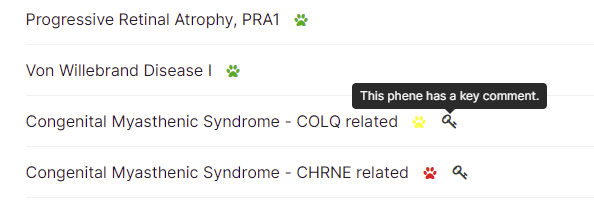HGTD This week: NEW feature - Key Comments
HGTD This Week: NEW feature - Key Comments
In our continued effort to improve HGTD, we have a new addition to our breed-specific testing information. Complementing the Breed Relevance Ratings, the new Key Comments feature highlights in the breed search, any tests that have a comment related to the relevance of the test for that breed. Users can then click through to the phenes information to not only read the Key Comment, but also other general, and breed-specific information about the phene. Key comments are sourced from the researchers or test developers, as well as relevant experts.
What do Key Comments look like in the breed-specific test listing?
Look out for a "key" symbol next to the phenes in the breed-search list. If you see a key, then there is a key comment associated with this phene.
You can click on the phene name to read the key comment, as well as other information related to the test including: clinical information, application recommendations in the breed/dog, research/gene information, etc.
Once you click through to the phene, look out for the Key Comment information section.
What are examples of Key Comments?
Key comments are associated with the relevance of the test to specific breeds/types, and can vary in content. Provided by experts in the discovery or application of the test, the information could be related to how common the test is in a breed, specific concerns about the test for a particular breed, or breed-specific application of the test. This differs from the application information currently provided in phenes, which is a general comment on the test application and not breed-specific.
Examples of key comments are for the phene congenital myasthenic syndrome (CMS) in the Golden Retriever, and Golden Retriever crosses. There are currently two tests available for CMS that are available to the Golden Retriever. Each test is based on a different genetic mutation, and CMS is considered rare in the breed and its crosses. In this example, the key comment for the COLQ-related test is that it is very rare and may only be relevant for a specific line of Golden Retrievers, and not have breed-wide importance. Arguably more critical is the CHRNE-related key comment which notes that while this test may be applied to Golden Retrievers, it is actually an incorrect test. In these examples, the key comment not only has breed-specific information on the relevance and the BRR, it also supports test selection where the phene/test names are similar and may be confusing.
Who provides Key Comments?
Key comments are currently sourced from the original research, with the goal of testing and test results being informative and applied appropriately to a dog/breed. This is most often provided directly from the researchers, but may also be augmented with peer-reviewed publications and/or external links to additional information. In time, it may also include other breed and/or test expert comment.
Where can I get more information?
You are welcome to ask questions about key comments, or provide feedback by emailing aimee.llewellyn-zaidi@ipfdogs.com
Image via Pexels, H. Lopes.
 Donate
Donate

0 Comments
Recommended Comments
There are no comments to display.